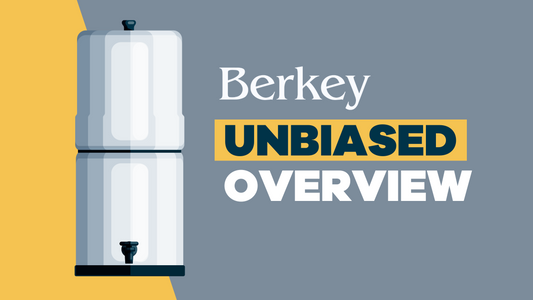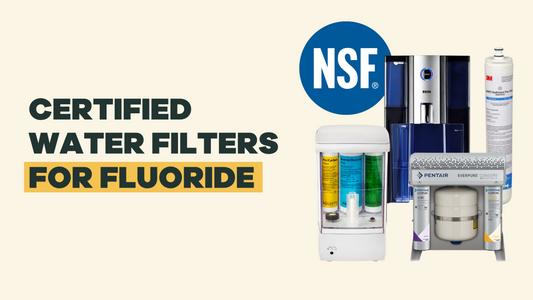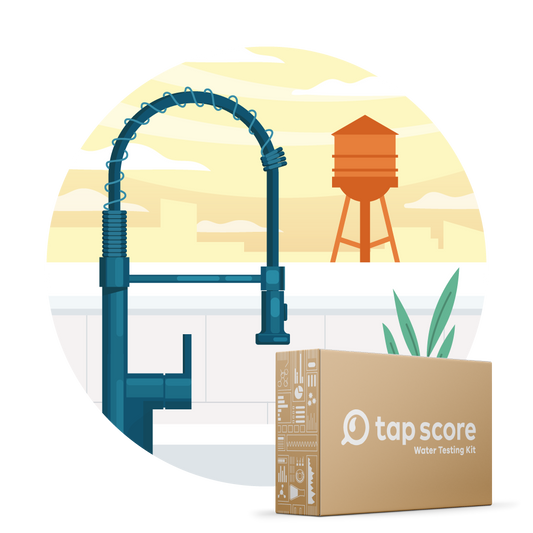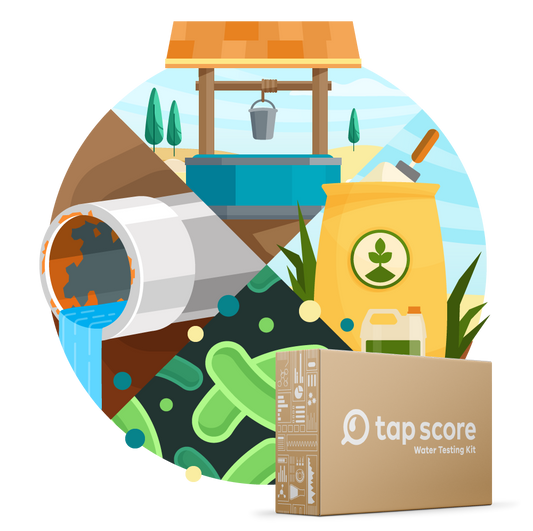
What Is Reverse Osmosis (RO)?
Our blog is written by real experts— not AI. Each guide is carefully reviewed and updated based on the latest research. Plus, with no affiliate links, you can count on unbiased insights you can trust.
Reverse osmosis (RO) is a water treatment technology that uses household water pressure to push tap water through a semipermeable membrane. The membrane blocks dissolved salts, lead, arsenic, nitrates, and many other contaminants, while allowing water molecules to pass through. The water produced by an RO system is very clean, with only low levels of contaminants remaining, if at all. The contaminants removed by RO are concentrated and discharged down the drain.
For those wondering if an RO system is the right fit, this guide will explain how reverse osmosis works, which contaminants it does and does not reduce, and some of the pros and cons of an RO system.
Table of Contents:
- What Does an RO System Include?
- What Does RO Reduce in Drinking Water?
- Pros and Cons of RO Systems
- Is RO Right for Me?
Key Takeaways
- Reverse osmosis refers only to the semipermeable membrane. RO systems typically contain additional pre-treatment and post-treatment filters.
- RO can reduce a large range of inorganic and organic contaminants in water, including metals, dissolved salts, PFAS compounds, and many others.
- It’s important to test your water at a laboratory before purchasing an RO system to make sure it’s the right option for your water profile.
What Does an RO System Include?
Reverse osmosis refers only to the semipermeable membrane, which is just one part of a full treatment system. RO systems typically contain additional pre-treatment and post-treatment filters. Each of the filters (including the RO membrane) are referred to as “stages.”
For example, if you see an RO system advertised as a 5-stage system, that means water passes through five stages of filtration before arriving at your faucet (so four stages in addition to the RO membrane).

Pre-treatment
RO membranes are very sensitive — the size of the pores in an RO membrane is about 0.0001 microns.[1] This means they are easily damaged if water is not properly treated before reaching the membrane. There are various pretreatment filters that may be needed to prevent fouling, scaling, and premature RO membrane failure:
- Sediment filters are used to filter out sediment particles such as sand, clay, and plant matter/microorganisms. If these particles are not filtered out, they can accumulate on the RO membrane and plug it up.
- Granular activated carbon (GAC) removes organic contaminants and disinfectants in the water such as chlorine or chloramines. Chlorine and chloramines are oxidizers and can react with the RO membrane and “burn” holes in it.
- Antiscalants/scale inhibitors are chemicals added to the water to prevent the buildup of scale on the RO membrane, which is common with hard water. Scaling happens when dissolved minerals become solid and deposit on surfaces.
If pre-treatment is not used or maintained properly, fouling and scaling can decrease water flow across the membrane and decrease water quality.
Post-treatment
Post treatment can include an additional GAC filter to remove any remaining organic contaminants (i.e., those that cause taste and odor issues), remineralization/alkaline treatments, or UV treatment for bacteria.
What Does RO Reduce in Drinking Water?
RO can reduce inorganic and organic contaminants such as (but not limited to):
- Arsenic
- Nitrates
- Sulfates
- Lead, aluminum, copper, nickel
- Dissolved solids/salts
- Pesticides/herbicides
- PFAS compounds
- Microplastics
Reverse osmosis is not very effective at reducing dissolved gasses (like hydrogen sulfide), and certain solvents and VOCs.[2] Although some of these compounds may be reduced by the carbon pre- or post-filters, it is not guaranteed.
Pros and Cons of Reverse Osmosis Systems
| Pros | Cons |
|---|---|
| Removes 90–99 % of dissolved salts, heavy metals, arsenic, nitrates, fluoride, PFAS, and microplastics, among other contaminants. | Generates waste concentrate—about 2–4 L of discarded water for every 1 L of purified water (1:1 systems can halve this); your water usage and bill will most likely go up. |
| Greatly improves taste and odor, in part by lowering total dissolved solids (TDS). | Strips beneficial minerals (calcium, magnesium); water can taste “flat” unless remineralised. |
| Compact under-sink units fit most kitchens; whole-house systems are available. | Requires a dedicated faucet and a drain-line connection—installation can be tricky in rentals. |
| Pairing an RO membrane with additional activated carbon stages (pre- and/or post-filters) helps to reduce compounds that are harmful to RO membranes (like chlorine) and others that RO membranes are not suited to best remove (like VOCs). | Filters need regular replacement (pre-filters every 6–12 months, membrane every 2–3 years) to maintain performance. |
| Works across a wide pH range and on both city and well water (with appropriate pre-treatment). | Supply pressure below ~40 psi may require an electric booster pump. |
| Optional UV post-treatment can deliver near-sterile drinking water. | Up-front cost: roughly US$150–500 for an under-sink unit, plus any plumbing fees or DIY time. Replacement filters are an ongoing cost. |
Is My RO Water Filter Leaking?
Is a Reverse Osmosis System Right for Me?
If you have a problem with inorganic contaminants such as arsenic, fluoride, or nitrates, or TDS reduction is a high priority, then RO might just be the right option for you. If you have multiple water quality issues that include both organic and inorganic contaminants, reverse osmosis will cover all your bases.
It’s important, however, to know your water before you commit to the significant investment that RO systems require. Always test your water with a certified laboratory before making any treatment decisions.
Why Should You Test Before You Install an RO?
Because RO is expensive and creates a fair amount of wastewater, you’ll want to make sure this is the right choice. Further, membranes can be damaged by certain contaminants present in your water, so knowing what type of pretreatment you need is essential.
Tap Score offers an array of mail-to-lab test kits that provide easy-to-read results—and even make unbiased treatment recommendations.
Public Utility Customers:
Private Well Owners:
A lab test might reveal that your particular situation would be better suited with a different treatment system.
Top 4 Water Filtration Technologies For Homes
Frequently Asked Questions
How does reverse osmosis work?
Reverse osmosis uses household water pressure to push water through a semipermeable membrane, blocking dissolved salts, metals and other contaminants while allowing water molecules to pass through.
Does RO remove lead?
Yes — RO membranes typically remove 94-98 % of dissolved lead ions.
Will RO remove microplastics?
Because microplastics are far larger than the 0.0001 µm membrane pore size, RO effectively rejects them.
Does reverse osmosis remove PFAS?
Yes, RO treatment systems are considered effective at removing PFAS compounds. It's crucial to keep your RO system properly maintained to safeguard effectiveness — especially if high levels of PFAS are a known contaminant in your water supply.
Is RO water acidic?
Pure RO water is slightly acidic (pH ≈ 6-6.5) but remineralisation filters can bring pH back to neutral.
How much waste water does an RO system generate?
Typical residential units send 2–4 litres of concentrate to the drain for every litre of purified water, though some modern systems cut this ratio to 1:1.
How often should I change RO filters?
Sediment and carbon pre-filters: every 6-12 months; RO membrane: every 2-3 years; post-filter: every 12 months, depending on usage and water quality.










